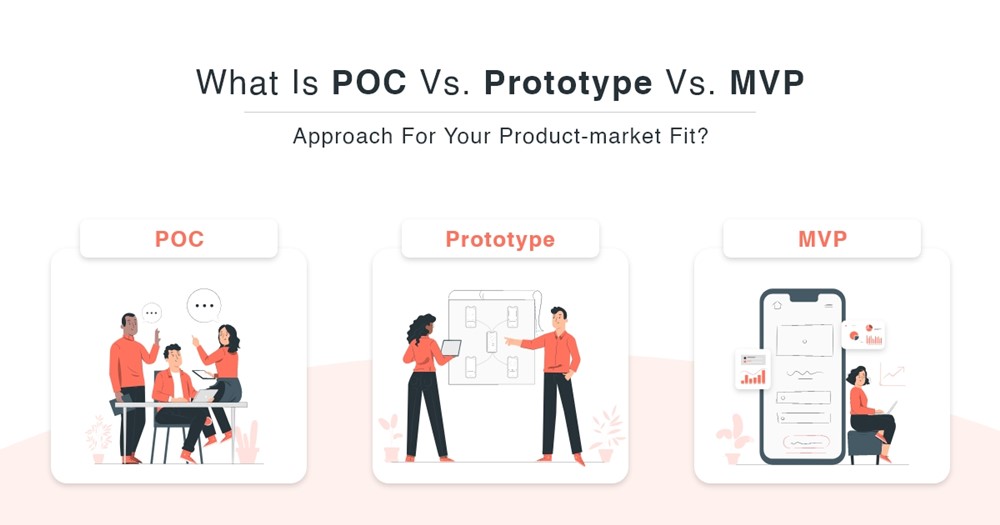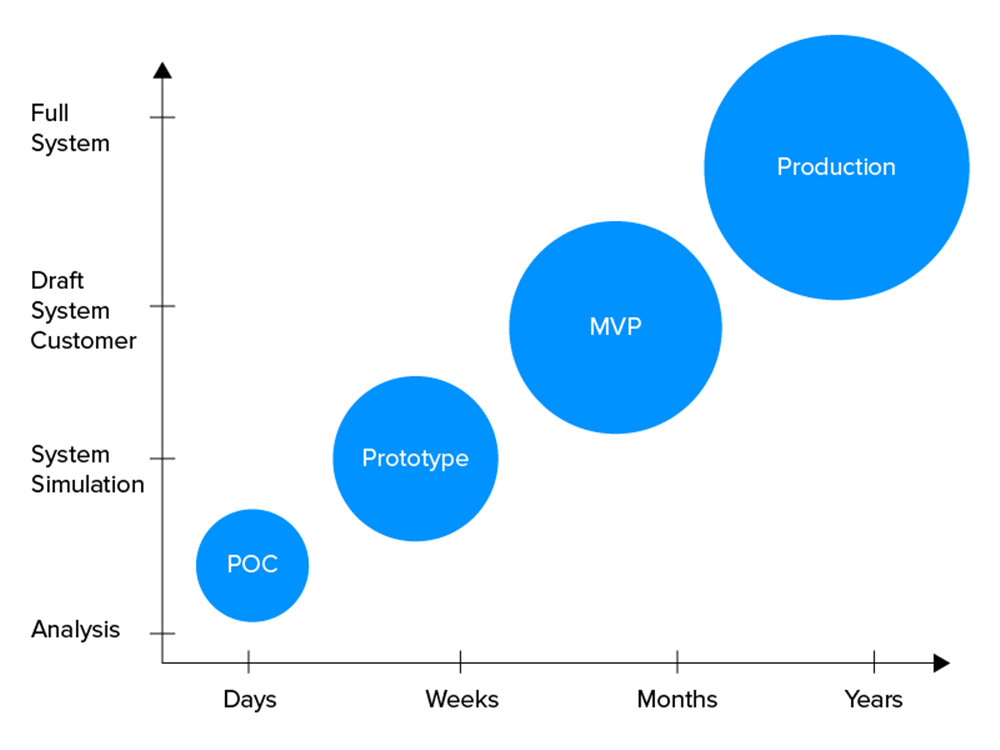Understanding PoC, MVP and Prototype | Savvy Development Guide
People tend to say, knowing the battle is already half the victory. And all the concepts that we’re going to discuss today in this article regarding – PoC vs Prototype vs MVP – are about preparing and giving an excellent headstart for Startups/Businesses. Depending on the app development process, as a leading software development company – Savvycom will work on building these concepts. Often than enough, you will find these terms relevant for companies at the Concept, Pre-Seed, and Seed stages but they’re still often misunderstood and misused.
In short, building good digital products is a combination of being innovative and following tested app development methods. A proof of concept (POC), prototype, and minimum viable product (MVP) help push, test, and probe a product idea before you make any further significant investment.

In this article, we will cover:
- The concept as well as the difference between PoC, MVP, and Prototype.
- Full explanation of when and why you should use each of these concepts.
- Guide on how to get the most out of them for the benefit of your product and business.
Without further delay, let’s take a look at the definitions of these concepts.
1. POC vs. MVP vs. Prototype: Overview
Before we go in-depth into each concept, allow us to outline a few key pieces of information that you need to keep in mind. Since it’s essential to lay out the whole picture, so we don’t get confused later on in the article:
- A PoC, a Prototype, or an MVP aren’t different forms of your Product. Actually, only the MVP refers directly to your end-Product.
- They refer to different stages in Product development. The most proper sequence to follow is a PoC to a Prototype to an MVP.
- Another noticeable difference between a Prototype and a Proof of Concept vs. an MVP is that while MVP development is a general recommendation for all Startups, your Project may not need a PoC at all. Functional prototypes are a good idea almost always, but it’s also something that may seem excessive in certain situations.
In case you wish to work with Savvycom, we will guide you through the process and give you further recommendations on what you should and shouldn’t do.
- Both a Prototype and a PoC are used at the pre-Product Stage. They must validate ideas and assumptions that refer to tech feasibility (it’ll be a PoC) or UI/UX designs (for Prototypes).
- An MVP is built at the Product Stage and released for pre-registered users of your product.
Have a Project Idea in Mind?
You are more than welcome to contact our Partnership Manager for a free consultation.
In case you need a short explanation after what we have stated above:
- Proof of Concept – A POC is a method of validating assumptions with target users and checking if your idea is possible technically.
- Prototype – A mobile app prototype evaluates your idea’s general “shape” (e.g., look, flow, user interaction).
- Minimum Viable Product – An MVP is a fully working version of your product with only the core features that let you collect initial user feedback.
2. Proof of Concept: Validate Your Tech Idea
In the world of technology, a POC is a simple project that validates or demonstrates an idea. And the purpose of a POC is to check whether an idea can be developed without consuming an excessive amount of resources or time. With a POC, you basically evaluate core functionality. If your idea is complex, you can have to prepare many POCs to test each functionality.
User experience is, however, pushed aside when you build a POC. That’s because it takes lots of time and effort to create an optimal user experience which is not the point of creating a POC.
A Proof of Concept (PoC) is a small project to verify that some tech concepts (method, technology, integration, etc.) are implementable.
2.1. How To Differentiate a Proof of Concept?
So, how is PoC different from an MVP or a Prototype? Here are a few essential things to remember:
- A PoC isn’t for customers – The purpose of a PoC is to validate some tricky tech assumptions. Usually, you don’t even show it to end-users. In fact, it will be probably reviewed only by your in-house experts.
- A PoC isn’t for investors (but can be advantageous) – This is true if you’re seeking funding at the early stage. You may show your Proof of Concept to investors to demonstrate that you have more than just an idea and that your idea won’t fail due to technical reasons.
- A PoC isn’t a “simple version” of your Product – The PoC tends to have a short lifecycle, non-reusable assets, a simplified UI, often made without security in mind, etc. When creating a PoC, developers also make sacrifices to the code quality to speed up the process since they mainly rely on hard-coded elements, static data, mocked APIs, and so on.
So if you compare a Proof of Concept vs. a Prototype, the main aim of any PoC is to prove whether some technical aspect of your future product can be implemented. This is purely a “yes/no” question that provides you with clarity on whether it’s possible to even build your product at all.
2.2. Features of a Proof of Concept
- Catch Early Investor Interest – You can build a POC to present your idea to investors to acquire seed funding for further development.
- Creativity – Innovation often tends to happen at the intersection of technological viability and market demand. A POC will help you check if your idea can be built using currently available technology.
- Time-Saving – When you check if your idea can be built, you automatically save time that would be wasted if you were to figure out technical viability issues once you hired developers and committed significant resources and time.
- Choose The Ideal Tech Stack – Creating many POCs using different technologies can help you decide which technology stack is the most efficient for your project. This way, you’ll know exactly early on what’s possible as you move forward and how to structure your product’s roadmap in the future.
- Competitor Analysis – If you plan to release a mobile application in a heavily competitive market, a POC will help you validate unique features in your product as well as a unique approach to solving the same problem.
3. Prototype: Visualise Your Idea
A prototype is where your product’s design begins to take shape and form. Suppose a proof of concept evaluates the technical side. In that case, a prototype aims to answer the question of how the product will look and feel.
Creating a prototype relies on a cross-functional team effort where designers, developers, and product owners align on the product’s design. Prototypes help you figure out what UI elements should be included and how the user will interact with them.
Prototypes can take many forms – from simple paper-based wireframes to interactive “clickable” versions developed in Figma. A Prototype is an interactive visualization of your future product that demonstrates user flows and the main design elements that you will interact with.
3.1. How To Differentiate a Prototype?
In some way, a PoC vs. a Prototype solves the same problem, albeit from different perspectives. While a Proof of Concept confirms that your Product is possible from the technical point of view, a Prototype ensures that users won’t have any troubles with the UX while using it.
Another similarity between a Proof of Concept and a Prototype in product development is that they both have a short lifecycle. It’s only used for user testing, demonstrations, discussions, etc. When you polish your concept and move to product development, the Prototype will become obsolete.
3.2. Features of a Prototype?
- Time to Convince Investors – A prototype is a great way to get investors to consider and back your product, especially in the later state of fundraising.
- Optimize Your Resources – When you start with a prototype, you can identify UI elements of the app that have flaws and should be removed before the development phase.
- Iterate Designs – Interactive prototyping tools such as Figma help designers create many design iterations in a relatively short time. You can choose the best-performing design and run some internal experiments.
- Collect Feedback – A prototype lets you ship your product for testing in order to get initial feedback. User testing in this phase can go a long way to improving and helping you chisel out the design while having plenty of time to fix flaws.
- Polish Idea – With a prototype, you can simplify your product idea and transform it into a visually appealing format. A prototype will give the idea a more refined form if a proof of concept confirms the idea can be built.
Okay, at this stage, you should be able to prove that your idea is indeed possible from a technical perspective and know how to implement it from the UI/UX perspective. Let’s move on to the next, which is “Build an MVP!”
Never Miss a Deadline with Savvycom
Get in touch with Savvycom for a free consultation. We’ll help you decide on next steps, explain how the development process is organized, and provide you with a free project estimate.
4. Minimum Viable Product: Solve the Problem
There are many definitions of a minimum viable product, and, truth be told, there’s no definite one. An MVP for one project might have a different purpose for another:
- In other words, an MVP depends on the context of your product and organization. One company’s minimum set of features might amount to a complex application in another’s eyes.
- A minimum viable product helps you measure the demand and product-market fit – whether your product attracts early adopters and satisfies them.
- An MVP should contain the minimum number of features that still make your product marketable. Remember, the goal is to collect and analyze user-generated data and feedback.
And in order to do all that, you must remember that minimal doesn’t mean inferior or straightforward. That’s often misunderstood. While an MVP has only the core functionalities, it should be a high-quality, unique, well-performing release of your product.
A Minimum Viable Product is a Product that has a minimum set of features to satisfy early customers and collect feedback for further future development.
4.1. How To Differentiate an MVP?
The key difference between all three concepts, “Prototype, PoC, and MVP” is that only the MVP, in this case, is a usable Product. It’s not something you do for your in-house staff and internal testing and is shown only to a limited number of stakeholders but publicly released to everyone.
With every subsequent iteration of your MVP, you know more about your users’ problems and can further refine your solution. You continue to update and upgrade until your MVP becomes a full-fledged product that satisfies your audience’s needs and pain points.
To put it shortly, the key idea here is to create a Product with a minimum set of features to satisfy early adopters – people with the most intense and frequent need to solve the problem. By giving your solution to them, you can check whether its core idea is viable.
4.2. Features of an MVP?
- Get User Feedback – An MVP is an excellent tool to find out what your early users think about your product, and learn from their feedback to improve the product’s next versions.
- Save Resources and Money – Because you don’t have to implement all of the features into your MVP, the development work is reduced. Also, by analyzing user feedback, you can build a clear product roadmap and development route. The risk of over-building features will be minimized. A minimum viable product also allows you to introduce gradual product expansion, meaning you start working on another release after you have secured funding.
- Attract Investors – While a POC and a prototype can help you raise seed funding, an MVP can help you gain major investment. After all, if your MVP gains traction and raises positive feedback, investors are more likely to be convinced to back your business idea with money.
- Monetization – With an MVP out on the market and sufficient marketing, you can start acquiring paying users that will support your growth and development plan.
5. POC vs. Prototype vs. MVP: Which is the Best Approach?

With that said, every project is different and requires a custom approach. Maybe your business idea is exceptionally complex and might need to go through all three stages of development to ensure a cost-effective approach to delivery.
Going from a POC through a prototype and MVP is necessary to validate your idea thoroughly and invest resources only after you’ve confirmed your product is likely to gain traction on the market. The exact approach to software development service depends on the amount of data and resources you have when you start building it.
Savvycom – Your Trusted Tech Partner
From Tech Consulting, End-to-End Product Development to IT Outsourcing Services! Since 2009, Savvycom has been harnessing the power of Digital Technologies that support business’ growth across the variety of industries. We can help you to build high-quality software solutions and products as well as deliver a wide range of related professional services.
Savvycom is right where you need. Contact us now for further consultation:
- Phone: +84 24 3202 9222
- Hotline: +84 352 287 866 (VN)
- Email: [email protected]


